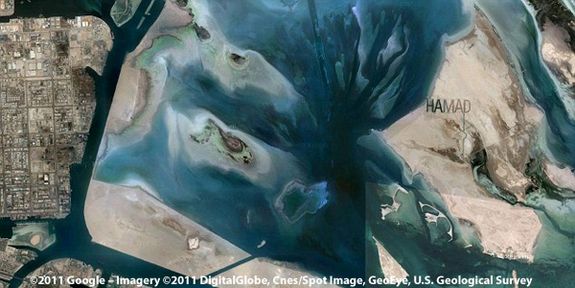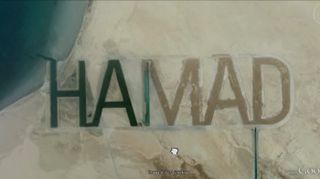Sheikh's Name Written in Sand Visible from Space

Hamad bin Hamdan al Nahyan, a billionaire Sheikh and member of Abu Dhabi's ruling family, has had his name carved into the sandy surface of an island he owns in the Persian Gulf. It is no lackadaisical sand-scrawling, though: At half a mile tall and 2 miles long altogether, the letters HAMAD are visible from space.
Satellites captured these images of al Futaisi Island, stamped with the name of its owner, back in 2009. They can be accessed on Google Maps and Google Earth. [The Top 10 Views of Earth From Space]

While, under normal circumstances, words written in sand wash away, The Daily Mail explains that these letters are large enough to "form waterways that absorb the encroaching tide." Indeed, at the time the satellite photographs were taken, said tide can be seen flowing through the letters all the way to the M.
Though Arabic is the official language of the United Arab Emirates, Hamad's native country, members of the media have speculated that he may have chosen to have his name carved in English instead so as to make it readable by more people. Others have pointed out that Arabic letters lack straight lines.
Hamad is also the man behind the world's largest truck: He commissioned an operational Dodge Power Wagon that is 64 times larger than the original and has a whole apartment inside. There's been no confirmation yet on whether his word — HAMAD — is the world's largest.
This article was provided by Life's Little Mysteries, a sister site to LiveScience.com. Follow us on Twitter @llmysteries, then join us on Facebook. Follow Natalie Wolchover on Twitter @nattyover.
Sign up for the Live Science daily newsletter now
Get the world’s most fascinating discoveries delivered straight to your inbox.
Natalie Wolchover was a staff writer for Live Science from 2010 to 2012 and is currently a senior physics writer and editor for Quanta Magazine. She holds a bachelor's degree in physics from Tufts University and has studied physics at the University of California, Berkeley. Along with the staff of Quanta, Wolchover won the 2022 Pulitzer Prize for explanatory writing for her work on the building of the James Webb Space Telescope. Her work has also appeared in the The Best American Science and Nature Writing and The Best Writing on Mathematics, Nature, The New Yorker and Popular Science. She was the 2016 winner of the Evert Clark/Seth Payne Award, an annual prize for young science journalists, as well as the winner of the 2017 Science Communication Award for the American Institute of Physics.











